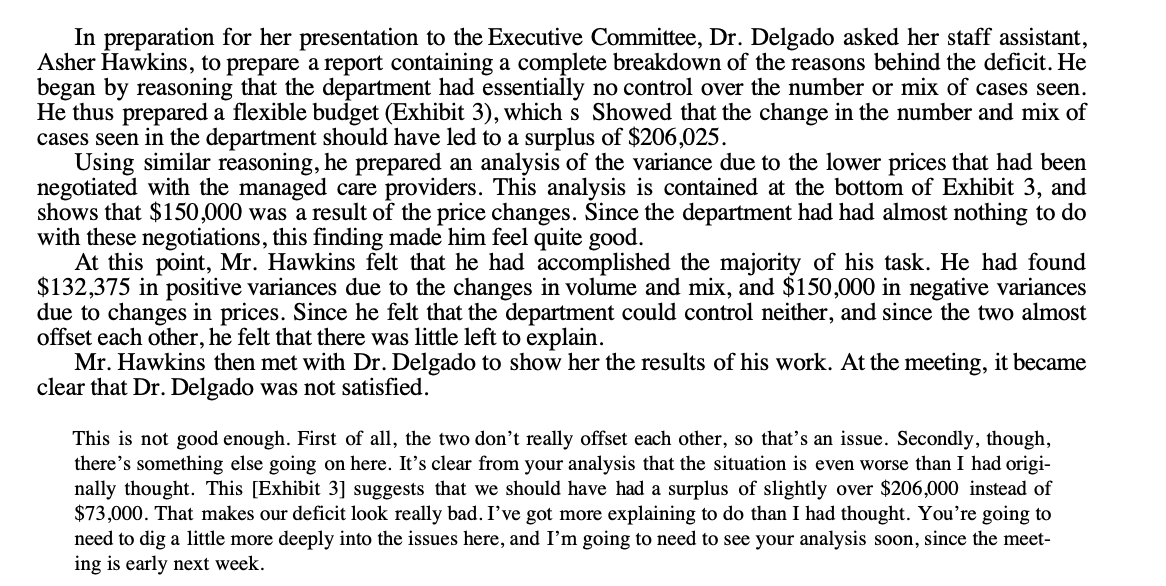You will write a consultant memorandum to better explain the financial loss the organization is experiencing and make data-driven recommendations to improve its performance. Points will be distributed as described below: 2 points for mentioning the variance amount needing to be explained; 4 points for the total usage variance; 4 points for the total rate variance; 2 points for the remaining variances; 4 points for your explanation of what these variances mean; 4 points for your recommendations that identify the 3 or 4 largest concerns and how specifically to address them. The analysis should be approximately 3 to 5 double-spaced pages plus any potential exhibits. The Los Reyes B Case will be posted and available in the Assignments section of the course assessments, where you will also upload and attach your paper.



Rate Variances Routine Care In preparation for her presentation to the Executive Committee, Dr. Delgado asked her staff assistant, Asher Hawkins, to prepare a report containing a complete breakdown of the reasons behind the deficit. He began by reasoning that the department had essentially no control over the number or mix of cases seen. He thus prepared a flexible budget (Exhibit 3), which s Showed that the change in the number and mix of cases seen in the department should have led to a surplus of $206,025. Using similar reasoning, he prepared an analysis of the variance due to the lower prices that had been negotiated with the managed care providers. This analysis is contained at the bottom of Exhibit 3 , and shows that $150,000 was a result of the price changes. Since the department had had almost nothing to do with these negotiations, this finding made him feel quite good. At this point, Mr. Hawkins felt that he had accomplished the majority of his task. He had found $132,375 in positive variances due to the changes in volume and mix, and $150,000 in negative variances due to changes in prices. Since he felt that the department could control neither, and since the two almost offset each other, he felt that there was little left to explain. Mr. Hawkins then met with Dr. Delgado to show her the results of his work. At the meeting, it became clear that Dr. Delgado was not satisfied. This is not good enough. First of all, the two don't really offset each other, so that's an issue. Secondly, though, there's something else going on here. It's clear from your analysis that the situation is even worse than I had originally thought. This [Exhibit 3] suggests that we should have had a surplus of slightly over $206,000 instead of $73,000. That makes our deficit look really bad. I've got more explaining to do than I had thought. You're going to need to dig a little more deeply into the issues here, and I'm going to need to see your analysis soon, since the meeting is early next week. Rate Variances Routine Care In preparation for her presentation to the Executive Committee, Dr. Delgado asked her staff assistant, Asher Hawkins, to prepare a report containing a complete breakdown of the reasons behind the deficit. He began by reasoning that the department had essentially no control over the number or mix of cases seen. He thus prepared a flexible budget (Exhibit 3), which s Showed that the change in the number and mix of cases seen in the department should have led to a surplus of $206,025. Using similar reasoning, he prepared an analysis of the variance due to the lower prices that had been negotiated with the managed care providers. This analysis is contained at the bottom of Exhibit 3 , and shows that $150,000 was a result of the price changes. Since the department had had almost nothing to do with these negotiations, this finding made him feel quite good. At this point, Mr. Hawkins felt that he had accomplished the majority of his task. He had found $132,375 in positive variances due to the changes in volume and mix, and $150,000 in negative variances due to changes in prices. Since he felt that the department could control neither, and since the two almost offset each other, he felt that there was little left to explain. Mr. Hawkins then met with Dr. Delgado to show her the results of his work. At the meeting, it became clear that Dr. Delgado was not satisfied. This is not good enough. First of all, the two don't really offset each other, so that's an issue. Secondly, though, there's something else going on here. It's clear from your analysis that the situation is even worse than I had originally thought. This [Exhibit 3] suggests that we should have had a surplus of slightly over $206,000 instead of $73,000. That makes our deficit look really bad. I've got more explaining to do than I had thought. You're going to need to dig a little more deeply into the issues here, and I'm going to need to see your analysis soon, since the meeting is early next week










